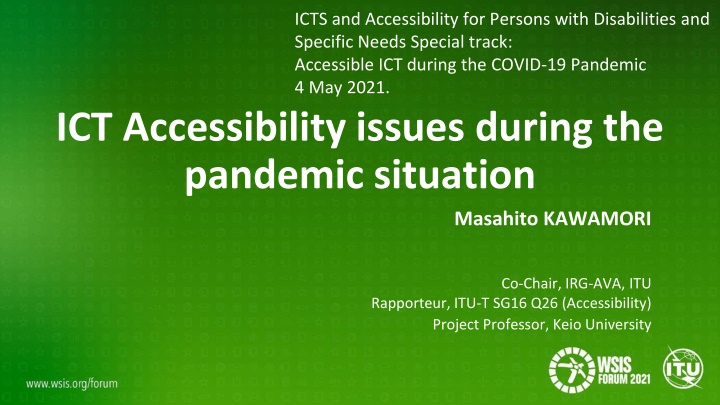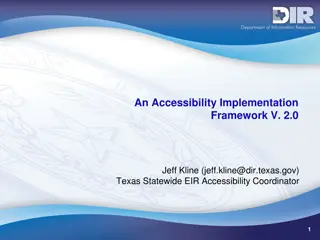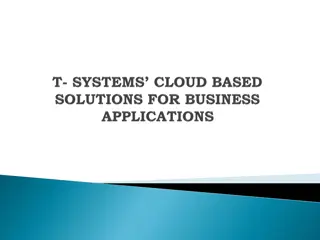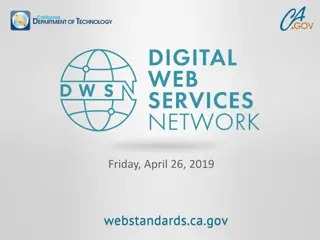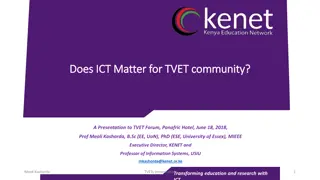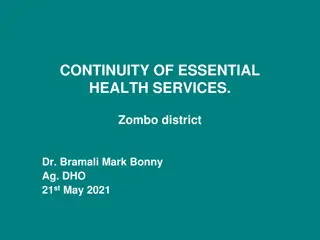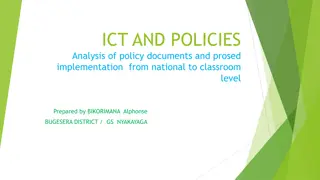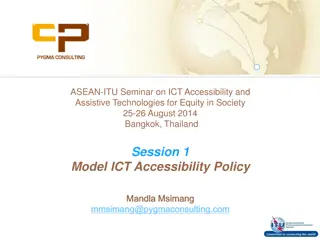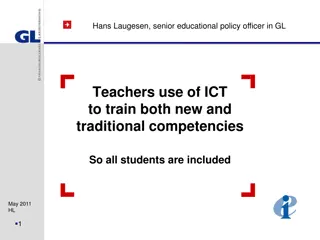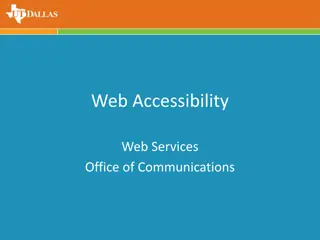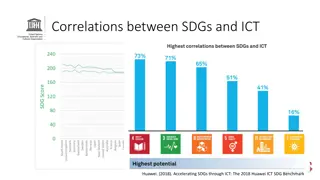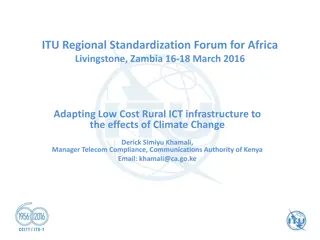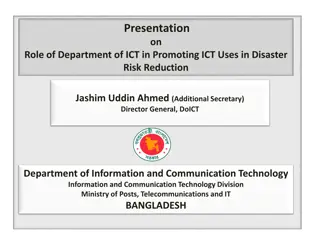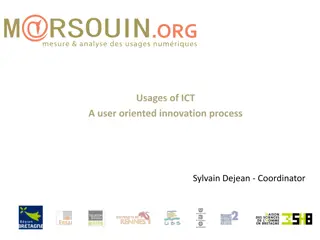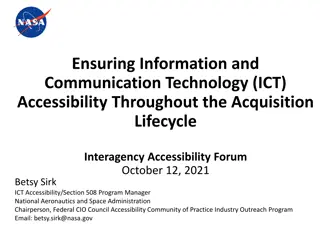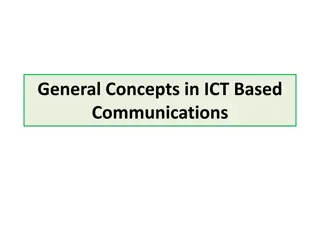ICT Accessibility During the COVID-19 Pandemic
Quantum leap in digitalization during the pandemic has accelerated the essential role of ICT accessibility, ensuring persons with disabilities are not left behind in the new normal. Vulnerable populations, including those with disabilities, face challenges in accessing vital information and services, underscoring the critical importance of inclusive digital strategies. The rapid pace of digital transformation emphasizes the imperative of adopting ICT accessibility as a fundamental necessity post-COVID-19.
Download Presentation

Please find below an Image/Link to download the presentation.
The content on the website is provided AS IS for your information and personal use only. It may not be sold, licensed, or shared on other websites without obtaining consent from the author.If you encounter any issues during the download, it is possible that the publisher has removed the file from their server.
You are allowed to download the files provided on this website for personal or commercial use, subject to the condition that they are used lawfully. All files are the property of their respective owners.
The content on the website is provided AS IS for your information and personal use only. It may not be sold, licensed, or shared on other websites without obtaining consent from the author.
E N D
Presentation Transcript
ICTS and Accessibility for Persons with Disabilities and Specific Needs Special track: Accessible ICT during the COVID-19 Pandemic 4 May 2021. ICT Accessibility issues during the pandemic situation Masahito KAWAMORI Co-Chair, IRG-AVA, ITU Rapporteur, ITU-T SG16 Q26 (Accessibility) Project Professor, Keio University
Digital Transformation and New Normal COVID-19 Pandemic has accelerated the digitalization of society with a quantum leap Companies have accelerated the digitalization of their business operations by three to four years. Many companies believe this is of lasting nature, staying in the Post-COVID This is also true for healthcare: at the beginning of 2020, digital strategy initiatives around telehealth and digitalization were something nice to have . But the COVID-19 pandemic has made them absolutely essential for healthcare organizations.
ICT for fight against COVID-19 COVID-19 is the first pandemic in human history, where technology and social media are being used on a massive scale to keep people safe, productive and connected, while being physically apart. (ITU/WHO) Information and Communication Technology (ICT) has now become an essential tool in providing vital services wider population this is especially true for persons with disabilities. ITU is also working with persons with disabilities worldwide
Vulnerable people are most severely affected But this is a "double-edged sword" for Persons with Disabilities: They are potentially the most vulnerable segment, They could be "left out" of this new trend of rapid digitalization. It is the vulnerable segment of the people that are most severely affected, in particular those with disabilities. the world s 1 billion people living with disabilities are among the hardest hit by COVID-19 (UN Secretary-General Mr Antonio Guterres) Persons with disabilities face a lack of accessible public health information, significant barriers to implement basic hygiene measures
ICT Accessibility is essential If almost everything goes digital and online , persons with disabilities should not be left behind -- digitalization should be inclusive The rapid pace of digitalization of society calls for rapid adoption of ICT accessibility ICT Accessibility is an absolute necessity, not something "nice to have" in the post-COVID-19 "New Normal"
Care/Welfare and ICT Accessibility COVID-19 forces everyone to keep social distancing Many, if not most, services go distant , online , and remote Many heretofore "face-to-face" professions such as healthcare, welfare, etc., should accelerate the adoption of ICT and embrace ICT accessibility With society going digital, healthcare and welfare too should go digital so that no one will be left behind
Need for Digital Healthcare and Welfare ICT Healthcare and welfare need to be digitized and go online to provide necessary information and care to persons with disabilities and other vulnerable segments of the population Related areas, such as sign language interpretation, should also be available online Framework of digital healthcare and welfare ICT as well as for related services should be established guidelines for use of digital technology and ICT should be defined and improvement of digital literacy should be made International bodies and cooperation among them are needed
VRI as a Tool for Total Conversation VRI is a service that provides interpretation and assistance remotely using video, audio and text communication For deaf person Sign language interpretation Hard of hearing Text communication (sometimes using ASR) Blind person Audio description and guidance (For foreigners spoken language translation can also be provided)
Accessibility as Prime Necessity The picture shows a nurse using a smart phone to provide make- shift VRI to a deaf patient with COVID-19, via a sign language interpreter in a remote place. VRI is an essential tool for in- hospital (deaf) patients
An Example of VRI System Sign Language and other assistance Persons with Specific Needs Video communication Captioned Text
Some requirements on VRI Security VRI needs to be secure, protecting the privacy, even in medical setting, of the participants with e.g., EE2E Useability Should be very easy for PWD, including blind people, to use, avoiding complicated set-up, registration, etc. as much as possible Affordability As it is used daily, it should not be costly Availability Should be widely available, not requiring any special hardware a/o devices, preferably workable on any browsers
Importance of Interoperability and Standards Non-interoperable devices and services are esp. difficult for persons with disabilities Standards based universal design will help accessibility e.g., a single raised dot on the 5 key of a telephone terminal ICT should also be standardized Emergency call number --112, 911, etc. Standardized ICT will enhance accessibility for persons with disabilities Standards will make services more affordable --Open source, International organizations, like ITU, and governments can play an important role in this respect
Conclusion COVID-19 Pandemic has accelerated the digitalization of society But this is a "double-edged sword" for Persons with Disabilities: They are potentially the most vulnerable segment, They could be "left out" of this new trend of rapid digitalization. ICT Accessibility is an must have , not something "nice to have" during COVID-19 Many heretofore "face-to-face" professions should accelerate the adoption of ICT and ICT accessibility One example is VRI, as a universal Total conversation Tool for especially during COVID-19 Security, useability, affordability, wide availability are key Key to success is standardization:
